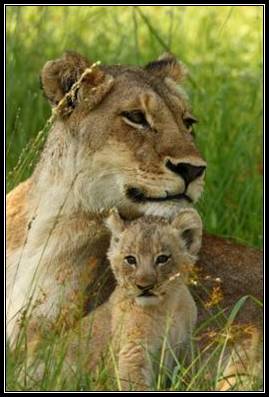26 Jan 2010
Location: Savuti Camp, Linyanti Concession, Botswana
Date: 20 December 2009
Observers: James Weis, Nicky Glover and Sefo Oganeditse
Guests recently visited Savuti Camp in northern Botswana and were lucky enough to spend an afternoon with a pride of lions that reside along the now-flowing Savute Channel. This sighting demonstrates the dynamic nature of this region and specifically, some of the effects that the “new” water has on the animals living here.
The Savute Channel, which connects the Linyanti River on Botswana’s northern border with the Savute Marsh in the Chobe National Park some 60 kilometers away, only began filling with water again in 2008. Before that time, it last flowed from 1967 to 1981 and so until recently, the resident animals here only experienced this Channel as dry grassland. However, this cycle of wet and dry is a phenomenon that has occurred on and off here over the centuries.
Guests sighted the Selinda Pride or the DumaTau Pride consisting of five adult lionesses and three young cubs, all of which belonged to one of the females, in the late afternoon – just when the light was turning to the gold hues that sets the tone for incredible wildlife images.
The pride had just begun to move again after waiting out the 90° F heat of the day and the group followed them, enjoying the playful antics of the little cubs, which were clearly anxious to start moving again after a long uneventful day.
The lionesses seemed hungry and the group was hoping for an opportunity to observe them hunting while keeping a safe distance in case they encountered impala or warthog. However, the lions never encountered anything to hunt, hence the group spent their time watching and photographing the cubs as the females walked through the bush and along the sand road leading to the Savute Channel a short distance away.
As the lions reached the main transit road, they turned toward the Savute Channel, which now covers this track in the sand for some 70 meters or so, with a small island in the middle. The water in the Channel is now deep enough in many spots to sustain pods of hippo and a number of crocodile were spotted along the Channel.
On a past visit this particular group, since the arrival of the “new” water, saw lion, cheetah, wild dog, hyaena, zebra, impala, giraffe, ostrich, kudu and various other animals crossing the water of the Channel which is not an uncommon occurrence.
However, with the arrival of hippo and especially crocodile further and further down the Channel, it has now become far riskier for the animals that dare to swim across.
The lions stood on the bank of the Channel and drank from the fresh, clean water and the four lionesses without cubs gazed intently at the opposite bank. These four seemed very keen to cross to the other side of the Channel.
The crossing in this location is not deep enough to force adult lions to swim a long distance, however for the small cubs, this would be a very strenuous swim and full of potential danger.
Guests watched in anticipation as the four other lionesses all waded into the Channel and the female with cubs followed a short way into the water as well, her cubs battling through the reeds and fighting to keep their heads above water as they tried valiantly to keep alongside of their mom. Suddenly, one of the cubs slipped completely under the water and his mother had to quickly reach in to fish him out with her jaws. The poor little guy looked like a wet rag as he dangled limply in his mother’s mouth.
It was now becoming a bit stressful to watch the unfolding drama everybody hoping that the mother would not force her cubs to follow the other lions, which had now begun crossing the Channel in earnest. A few tense moments passed as she called forlornly to her pride sisters and it was evident that she was torn between her desire to stay with her pride and her instincts to protect her cubs from danger.
As the four lionesses reached the far bank and shook off the water, the female with cubs continued to watch and call to them, but they strode off into the trees and out of sight. Long moments passed and the light started to fade and her cubs were shivering in the shallow water.
Finally she made her decision: she turned around and led her cubs back to the dry and sandy road beside our vehicle. Everybody watching was very relieved and happy to see that she had made her decision and what seemed to be the “right” decision at the time. The cubs carried on playing with their mother happily as dusk turned to darkness.
The flowing Savute Channel has obviously changed the lives of all the animals that live in this area. This pride of lions has its territory on both sides of what was once open grassland, but is now split by a flowing river. The act of simply traversing across their territory now poses new and potentially life-altering dangers.
These Sightings have been viewed in the Savute Area near these Camp’s: Savuti Camp






































You must be logged in to post a comment.